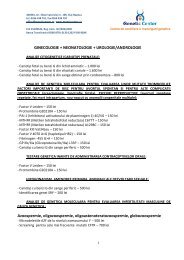Create successful ePaper yourself
Turn your PDF publications into a flip-book with our unique Google optimized e-Paper software.
Table 1. Age of pregnant women admitted to our department<br />
Age Number of patients<br />
19-24 years 15 (65.21%)<br />
25-30 years 6 (26.08%)<br />
>30 years 2 (8.69%)<br />
Table 2. Types of trauma in pregnant women admitted to<br />
our department<br />
Type of trauma Number of patients<br />
traffic accident 10 (43.47%)<br />
Fall from standing 4 (17.39%)<br />
Fall from height 3 (13.04%)<br />
Domestic violence 6 (26.08%)<br />
Table 3. Type of fractures and treatment<br />
Type of fractures Number of patients Treatment<br />
Distal radius fractures 7<br />
Vol. 4, Nr. 4/decembrie 2008<br />
3/external fixation, 2/<br />
conservative, 2/pinning<br />
Forearm fractures 4 plates on both bones<br />
Humeral diaphysis fractures 4 plates<br />
Femoral diaphysis fractures 2 1/nail, 1/plate<br />
cubitus fractures 2 plates<br />
Femoral supracondylar<br />
fractures<br />
2<br />
plates (Dynamic condylar<br />
Screw)<br />
Olecranon fractures 1 tension band<br />
clavicle fractures 1 plate<br />
Table 4. Type of anesthesia<br />
Type of anesthesia Number of patients<br />
Locoregional anesthesia 17 (73.91%)<br />
Spinal anesthesia 4 (17.39%)<br />
Still, two patients refused the radiological<br />
examination and with the help of clinical<br />
diagnosis, were immobilized in casts.<br />
This represented an exclusion criterion<br />
from our study.<br />
When radiography was performed we<br />
used radiological protection over the<br />
abdomen and pelvis (radiation-opaque<br />
apron) in order to protect the fetus.<br />
We analyzed the type of fractures that<br />
resulted as an effect of various trauma<br />
and we performed different surgical and<br />
orthopedic procedures adequate to the<br />
pathology (table 3).<br />
Surgery was performed on 21 of the<br />
patients (91.30%). The surgical treatment<br />
was in such manner elected as to reduce<br />
to minimum or exclude intraoperatory<br />
radioscopy. For instance, if normally for<br />
a supracondylar fracture of the femur<br />
we use a retrograde nail for fixation, in<br />
such cases we used a surgical method<br />
(plate fixation) that does not require<br />
intraoperatory radiological verification.<br />
Regarding anesthesia, the anesthetic<br />
was chosen after consulting with<br />
the obstetrician. If possible, we used<br />
regional anesthetic; spinal anesthesia<br />
was preferred in femur fractures. The<br />
two cases that did not need surgery did<br />
not receive an anesthetic.<br />
After surgery, the patients were transported<br />
to the Obstetrics Department.<br />
Local examination measured the dilatation<br />
of the cervix in order to assess<br />
the onset of labour and the risk of preterm<br />
delivery. Patients that presented<br />
rhythmical abdominal pain every 5-10<br />
minutes that lasted for at least 1 minute<br />
or any signs of genital bleeding were<br />
closely monitored.<br />
Cardiotocography was performed<br />
in order to assess the contractility of<br />
the uterus and the cardiac frequency<br />
of the fetus. In order to screen for<br />
abruptio placentae, an echographical<br />
survey was initiated on all the women<br />
(a retroplacentary lacunary image was<br />
considered pathological).<br />
Results<br />
We performed the follow-up for all our<br />
patients in order to monitor the possible<br />
complications of our treatment and the<br />
short-term side effect on the fetus.<br />
The echographical screening revealed<br />
that one of the patients presented a<br />
thin lacunar image retroplacentary,<br />
with no blood or amniotic liquid in<br />
pag. 227<br />
gineco<br />
ro



